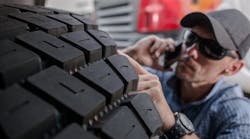Every aspect of life is affected by economic inflation. Whether we shop at the grocery store, dine at a restaurant, or fill up at the pump, we feel it everywhere. A dollar just doesn’t go as far as it used to. With no end in sight, companies are forced to adjust to rising costs. There are many ways fleets can try to save money, but it’s essential to know the difference between price and cost.
When focusing solely on price, the most important factor is the amount paid for the goods or services. The lowest price might have a minimal impact on profits in some cases, while in others, short-term savings can result in unexpected losses in the future. In times like these, the temptation to economize in certain areas grows harder to resist with each passing bank statement. Uncertainty in the economy may lead to poor buying decisions if price is the primary consideration.
Fleets are constantly pressured to keep freight moving at the lowest possible cost. Every component on the wheel end falls under the price vs. cost model. For example, studs and fasteners are wearable items that eventually require replacement. When the focus is only on price, operators are tempted to leave worn components in service rather than replace them. When replacing parts cannot be avoided, opting for the least expensive parts will result in higher costs if the decision results in a loose wheel or wheel-off. Spending a few more dollars on higher-quality wheel hardware before it fails can help prevent situations where vehicles and lives are at risk.
See also: Impact of tires on fuel economy and operating costs
Wheels are another area where the lowest price can increase costs per mile. A high-quality wheel will maintain its finish and durability over hundreds of thousands of miles. The rust and corrosion on bargain basement wheels will attract the attention of vehicle enforcement officials. And when a low-budget wheel suffers structural failure, it will be tested for strength and durability against a name-brand competitor. If those tests reveal an inferior product, any price savings up front will pale in comparison to attorney fees.
The same can be said when selecting a service provider. A tire company that is a one-man operation with a pickup truck and compressor may have the lowest price for labor, but the long-term costs of shortcuts and failure to follow industry-recommended practices can be astronomical. Consider a situation where the cheapest option fails to recognize an out-of-service condition on a wheel that ultimately leads to a wheel-off accident. Any savings on the front end will result in higher costs down the road, especially after litigation begins. The one-man operation may only have the bare minimum insurance coverage or, worse still, none at all. Fleets are responsible for their vehicles, so any injured parties will hold the fleet liable.
Tires are the second highest operating cost outside of fuel, so the cost vs. price comparison is even more pronounced, especially in fleets that use retreads. In applications where retreading is not an option because the risk of significant damage is too great, it may work out from a cost perspective. Low-cost truck tires are generally not retreadable, so they are thrown away after the tread wears out. Typically, the best cost-per-mile comes from a long original tread life followed by multiple retreads. Other factors may affect that equation, but casing preservation is the key to lowering costs even when tires cost more.
Truck tire repair is another area where price can negatively impact cost. Many fleets balk at the cost of a simple section repair and discard perfectly good casings. A minor injury in the sidewall or an injury to the crown larger than 3/8 inches is easily repaired in most retread plants. Reluctance may be justified when extensive injuries are present, but overly conservative section repairs leave money on the table.
Cutting costs by opting for lower-priced products is natural, but the wheel end is an area where quality matters. Saving a few dollars here and there can lead to astronomical expenses in the future. Cost is cumulative, so it should be the primary consideration when selecting, maintaining, or repairing tires and wheels.



